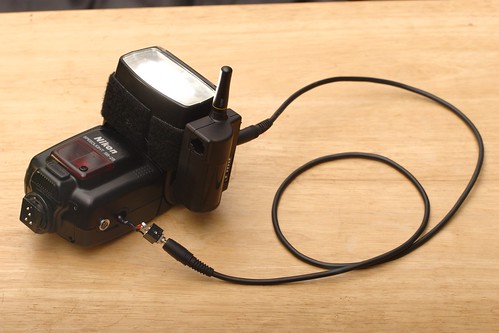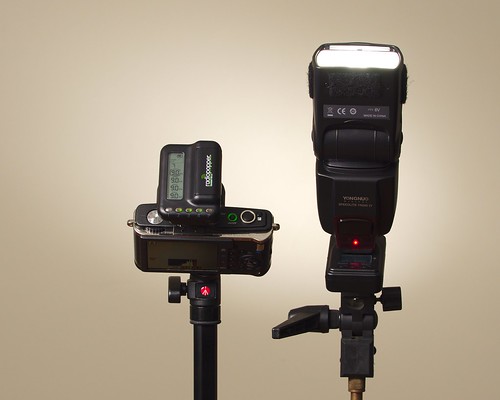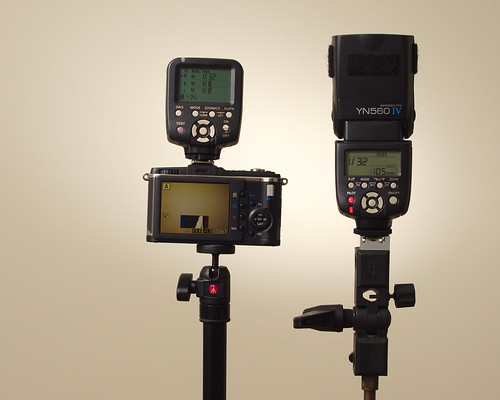Remote Flash in 2015
October 13, 2015
For about five years now, I’ve been using a set of old Nikon speedlights SB-25s and SB-26s modded to give me remote power control with my RadioPopper JrX triggers. It was a lovely little system for me, and I got accustomed to being able to adjust my power levels at will from a distance. Unfortunately, after five years of use things are starting to fall apart. The 3.5mm jack I hacked into one of my flashes came loose, and in a single day the plate on the bottom of my JrX transmitter fell off and I lost the foot of one of my flashes to a falling lightstand.
I finally had to admit that it was time to stop super-gluing things back together and update my flash system. First I went looking for a replacement to my fallen JrX transmitter, only to find that RadioPopper has discontinued the JrX line of radio triggers. I ended up getting my hands on three separate sets of triggers for some amount of time, so I’ll give a brief review of each in the hopes that it might save others some time and frustration of their own. If you just want to see the solution that ended up working for me, skip ahead to the last section.
RadioPopper Jr2
I started my quest with what seemed like the most logical step coming from RadioPopper JrX triggers: the new RadioPopper Jr2 line. They were a little pricy, but the transmitter would reportedly work with my existing receivers, so I figured I could use what flashes and receivers still workedwhile slowly upgrading my system, starting with one new transmitter and receiver. And as a bonus, the new receivers have a hot shoe directly on them, so I wouldn’t need to usemy clumsy 3.5mm sync mod any more. So far so good, right?
The only thing that concerned me was the fact that RadioPopper’s site didn’t explicitly list the flashes the receiver would be compatible with. Just to be sure, I checked with the company to see if my SB-25s and 26s would work with remote power control. The response I got back said that they weren’t sure about the 25s, but at the very least the SB-26 should work. That was good enough for me, since most of my flashes were falling apart anyways and in the worst case scenario I could just replace them all with SB-26s for a little more money. I went ahead and placed the order.
When the triggers finally arrived (the order took over a week to ship because of supply issues) I pulled them out of their boxes, set my SB-26 on the receiver, and then checked the manual (which is only available online) to figure out how to get remote power control set up. According to the manual, there’s a mode button you need to hold down to switch the receiver to “remote” mode, which will allow the transmitter to set power levels. So I held the button down, but it wouldn’t change. I tried it with the flash on and off, I tried sliding the flash onto the receiver after it was turned on, and I tried it with the flash in and out of TTL mode. No dice.
Hoping I’d just received a defective unit, I emailed support again. This time the response I got was that my SB-26 would not, in fact, work with the Jr2 receivers for remote power control. Although the power control itself uses the same old-school TTL system as always, it seems that the receiver expects some kind of digital connection to an iTTL-compatible flash before it will allow you to switch it into remote power mode.
Needless to say, I was disappointed. By requiring newer (and much more expensive) iTTL flashes to achieve remote power control, RadioPopper has really spoiled the promise of the Jr line. Sure, you could buy newer, more expensive flashes to go with the newer, more expensive triggers, but the entire reason I loved this product in the first place was that it gave me a simpleway to get remote power control without buying a lot of expensive hardware. As it stands, it’s difficult to imagine a good use case for these in conjunction with speedlights. If you happen to have a bunch of newer iTTL lights laying around, then you may as well just spend a little more to buy triggers that can give you full TTL functionality remotely. And if you don’t, well, who wants to pay all that money just to have remote manual flashes?
I’ll be sending my Jr2 triggers back shortly. Their email support isn’t highly responsive, and it’s taken me about two weeks to go from my initial query about SB-26 compatibility to finally getting a return authorization (that’s the only reason I still had them around to take a photo of yesterday). While I don’t see a whole lot of use for these with speedlights, they may still be a good option if you own a set of studio lights that they support. Speedlight compatibility aside the new interface is pretty nice, and the integration with studio lights should be much more straightforward. Just hope that you don’t end up needing a speedy resolution from their support team.
Yongnuo YN600EX-RT and YN-E3-RT
I’d heard about Yongnuo (a newer Chinese flash manufacturer) before but never really considered trying out their flashes. They generally price out similarly to used Nikon SB-25s and 26s, but the Nikons are built better even if they are a little old. Yongnuo’s claim to fame is reverse engineering the Canon and Nikon TTL systems, but since I mostly use flashes remotely with manual power I didn’t have any need for TTL compatibility. With the RadioPopper receivers demanding TTL flashes now, however, I wondered if I could buy Yongnuo’s Nikon iTTL compatible flashes and get the RadioPoppers to control their power remotely. After a little Googling I found that the answer to that was “no,” but Yongnuodid make a fascinating product that could potentially meet my needs.
Well, more accurately, Canon made a fascinating product and Yongnuo built a clone that could potentially meet my needs. Canon makes a speedlight called the 600EX-RT that has a complete, TTL compatible radio triggering system built into it. They also make a radio transmitter unit called the ST-E3-RT, which allows you to control the 600EX-RT flashes remotely. Of course, they’re expensive as all get-out. The ST-E3-RT costs over $250, and the 600EX-RT clocks in at a whopping $500. Clearly, way too much to spend when you’re just looking for some flashes that you can adjust manual power on remotely. Besides, I don’t use a Canon camera anymore (I switched to Olympus a while back), so I wouldn’t be able to use it anyhow.
This is where Yongnuo comes in. They make their own flash and transmitter, the YN600EX-RT and YN-E3-RT. You can probably guess which corresponds to which Canon product. The Yongnuo clones are actually a very impressive work of reverse engineering: they seem to be completely compatible with the Canon originals both on and off camera. Better yet, I found out, the YN-E3-RT has a “legacy mode,” which is supposed to allow it to work with non-Canon cameras. And at only $85 and $120 for the transmitter and flashes, respectively, an entire kit would cost me less than just the radio triggers for a comparable RadioPopper-based system.
To test it out before plunging in head first, I ordered just a single copy of the transmitter and flash from Amazon. I unboxed them, put batteries in them, and turned them on. They both looked basically like their Canon counterparts, albeit with drastically less impressive build quality (but hey, what do you expect from a $120 dedicated flash?). I put the flash in slave mode, made sure the channels matched, and sure enough I could control the power on the transmitter, push the “Test” button, and see it take effect on the flash. Awesome!
Until I actually put the transmitter on a camera. When I tried to fire my first test shot, nothing happened. I dug a little through the menus, found that the legacy triggering needed to be explicitly enabled, and turned it on. Still nothing. Growing a little suspicious at this point, I went back to the blog entries I’d been reading earlier that announced the legacy trigger updates to the transmitter and started digging through comments.
The comments on every single article confirmed what I was afraid of: the legacy mode doesn’t work. At all. Yongnuo says they added the ability to use the YN-E3-RT with non-Canon cameras, and the menu option is in fact there, but as far as I can tell it doesn’t do anything at present. I’m guessing they’ll probably fix this with a software update some day, but as of now (October 2015) you shouldn’t count on using the YN-E3-RT transmitter with non-Canon cameras. It could be a pretty impressive system for Canon users, but for me it went right back to Amazon. Luckily, I found another Yongnuo option that worked much better.
Yongnuo YN560-IV and YN560-TX
The tricky thing about Yongnuo is that they’re very much a Chinese company. They make products for the American market with mostly readable documentation, and they ship them to American retailers, but they don’t have much of an English language web presence. Their own English language site, yongnuo.eu, is badly outdated which basically leaves you with blog articles and product listings on B&H and Amazon to figure out what products they actually have available at any given time. The problem you run into there is that blog articles may be informative, but they’re generally written once and then left there (this post will inevitably suffer from the same problem down the road, so take note that as I’m writing this it is October of 2015). Product listings tend to be up to date, but oftentimes the older versions will be listed as well and you might mistake them for the current version.
I can’t remember exactly how I stumbled on the YN560-IV, but I’m glad I did. Yongnuo’s own website lists the latest flash in the YN560 series as the YN560-II, but there have been two new ones since they last updated. Excitingly, I found that this newest flash includes a built-in radio transceiver that can control not only power, but also mode (that’s right, you can remotely switch these flashesinto stroboscopic mode if that’s your thing) and zoom. Better yet, they make a simple, no-frills radio transmitter called the YN560-TX that sits on top of your camera and lets you control the 560 flashes. They come in “Canon” and “Nikon” variants, but the extra hot shoe pins are only used for auto-wake when you half-press the shutter. You can stick either variant of the transmitter on any camera with a standard hotshoe and it will just work.
Perhaps the most amazing part of this line is the prices. One of the flashes will run you about $70 (less than the price of a single Jr2 receiver!), and you can buy the transmitter for only $45. As you would expect the build quality isn’t great, and the menus aren’t the most intuitive (you’ll want to give the user manuals a once-over when you first pick these up), but at those prices they’re practically disposable. I’ve replaced my entire flash system with one transmitter and three flashes, and it cost me less than the price of a single new dedicated strobe.
If you’re starting out with wireless flash in 2015, or replacing an aging system like I was, I recommend the YN-560 system. It’s exactly what you need in a remote flash system–radio triggering and remote control–without any of the expensive bells and whistles you don’t. The build quality is questionable (personally, I’d gladly pay even twice as much for a comparable, better-built system if one ever came on the market), but they pump out light just as well as anything else, don’t require you to carry around separate receiver units, and gives you full control of the flash without having to come anywhere near it.


